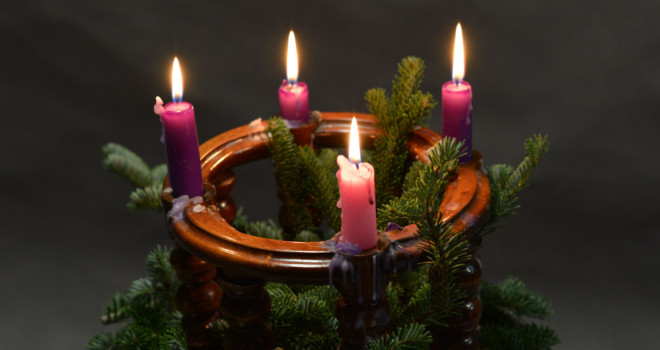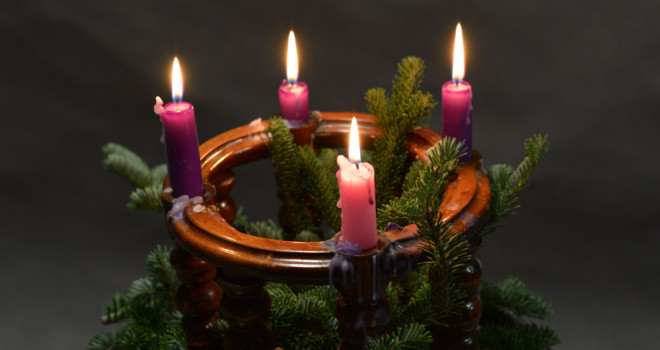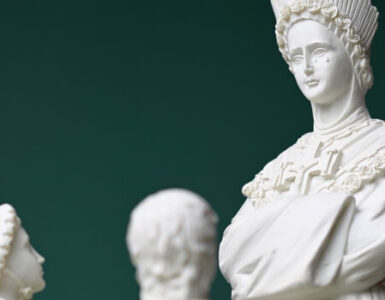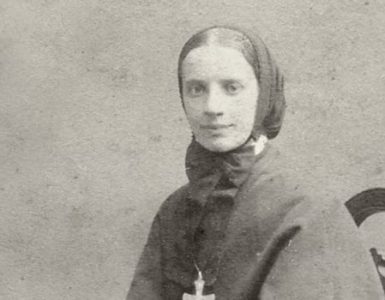
 The lights of the candles on the Advent Wreath break through the darkness, reminding us of the Light of Christ that we anticipate during this holy season. Where did this tradition come from, of lighting four candles in an evergreen wreath to mark the weeks preceding Christmas? Like many of our Church traditions, the use of candles in the midst of late fall and winter was originally a pagan tradition. Rev. William Saunders, who wrote an article in the “Arlington Catholic Herald” on this topic, states that “pre-Germanic peoples used wreaths with lit candles during the dark and cold December days as a sign of hope in the future warm and extended sunlight days of spring.” In a similar vein, Scandinavians “lighted candles [that] were placed around a wheel, and prayers were offered to the god of light to turn the ‘wheel of the earth’ back toward the sun to lengthen the days and restore warmth.”
The lights of the candles on the Advent Wreath break through the darkness, reminding us of the Light of Christ that we anticipate during this holy season. Where did this tradition come from, of lighting four candles in an evergreen wreath to mark the weeks preceding Christmas? Like many of our Church traditions, the use of candles in the midst of late fall and winter was originally a pagan tradition. Rev. William Saunders, who wrote an article in the “Arlington Catholic Herald” on this topic, states that “pre-Germanic peoples used wreaths with lit candles during the dark and cold December days as a sign of hope in the future warm and extended sunlight days of spring.” In a similar vein, Scandinavians “lighted candles [that] were placed around a wheel, and prayers were offered to the god of light to turn the ‘wheel of the earth’ back toward the sun to lengthen the days and restore warmth.”
In the middle ages, the Germanic peoples began incorporating a lighted wreath into the Christian season of Advent. It didn’t gain widespread popularity until the 1800s and it wasn’t until the 1900s that German immigrants brought the tradition to America.
The Advent Wreath is very symbolic. The evergreens used for the wreath itself are a reminder of continuous life. The shaping of them into a circle reinforces that meaning. The circle is also a sign of everlasting life as well as the eternity of God.
The four candles used, three purple and one pink, mark the Sundays of Advent before Christmas. The purple candles are reminders that this should be a time of prayer and sacrifice to prepare us for the second coming of Christ. On the third Sunday, the pink candle is lit to announce Gaudete Sunday, a Sunday of rejoicing for Christ is coming near. With the lighting of that candle, the light has won out over the darkness (three candles lit vs. the one that remains unlit).
Various meanings have been assigned to the four candles. One interpretation has each candle representing 4000 years, the Biblical time between Adam and Eve and the coming of Christ. In another interpretation, the first candle represents the patriarchs, the second the prophets, the third reminds us of John the Baptist, and the fourth of Mary, the mother of Jesus. They have also been described as the prophets’ candle, the Bethlehem Candle, the shepherds’ candle, and the angels’ candle.
A fifth white candle in the center representing Christ can also be used. It is lit on Christmas Eve as a remembrance of Christ coming into the world. Sometimes, all the other candles of the wreath are removed and replaced with white candles on Christmas.
The Advent Wreath serves as a powerful visual reminder of the holiness of the season. The light of the candles invite us to quiet ourselves during this busy time and reflect on the true meaning of Christmas. Whether at home or at Church, it provides an invitation to wait and pray in hopeful anticipation for the coming of Christ. We are called to welcome the light of Christ into our lives.










